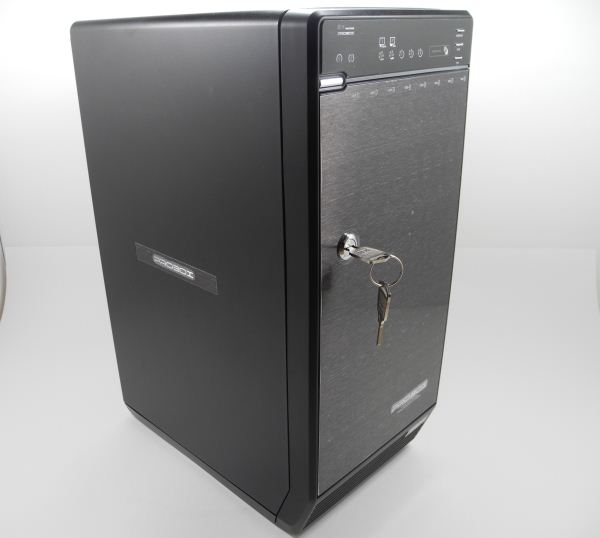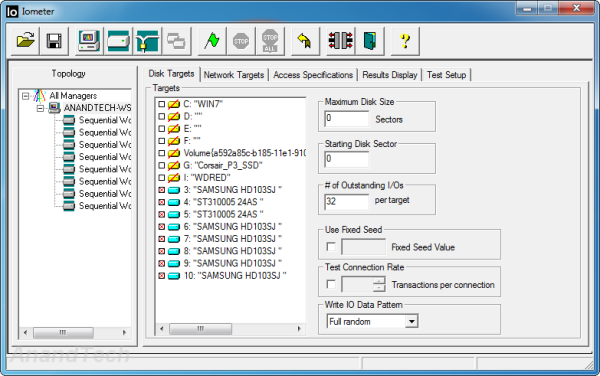Mediasonic Probox 8-bay 3.5" USB 3.0 / eSATA DAS Review
by Ganesh T S on August 4, 2012 7:55 AM ESTIntroduction
Prior to the rapid rise in popularity of Network Attached Storage (NAS) devices, consumers used to store large amounts of data on Direct Attached Storage (DAS) units. While USB 2.0 and Firewire used to be the interface of choice earlier, neither of them could maximize the bandwidth capabilities of the storage units (HDDs). USB 3.0 and eSATA serve the current day consumers in a more efficient way. We believe that the adoption of Thunderbolt in computing systems will make DAS units more relevant as the days go by. Today, we will take a look at the Mediasonic H82-SU3S2 3.5" USB 3.0 / eSATA Probox 8-bay external hard drive enclosure.
Mediasonic's H82-SU3S2 is a branded version of ODM manufacturer Hotway's H82-SU3S2, and utilizes a bunch of JMicron bridge chips. The unit is capable of being connected to the PC through either USB 3.0 or eSATA. The latter case needs a port multiplier aware SATA host controller on the PC side if more than one drive bay is being used. The operation is in single mode (JBOD) only, making the unit quite straightforward to use for the consumer.
Testbed Setup
Despite having a variety of systems with eSATA ports at my disposal, I was unpleasantly surprised to discovered that almost none of them had port multiplier capability inbuilt. These included boards based on the H55 and H65-M Intel chipsets as well as the AMD A50-M Hudson-M1. The A75 chipset in the ASRock A75 Pro4 supposedly has port multiplier capability. Unfortunately, ASRock confirmed that the current BIOS for that motherboard was not capable of supporting port multiplication.
In the process of sifting through the rest of the systems at my disposal, I found that the eSATA port on the Asus P8H77-M Pro that I had used for testing the HTPC credentials of Ivy Bridge was not from the H77 chipset, but, from a Marvell 88SE9172 SATA host controller. Though Asus doesn't specifically claim port multiplier support in the board, the data sheet for the Marvell controller indicated that it was compliant. In my initial testing, the port multiplier feature didn't work, but reinstalling the Marvell Magni driver after setting the eSATA port to be in AHCI mode resolved that issue (to some extent). There were no such issues with USB 3.0
| Mediasonic Probox 8-bay eSATA / USB 3.0 DAS Testbed Setup | |
| Processor | Intel Core i7-3770K - 3.50 GHz (Turbo to 3.9 GHz) |
| Intel HD Graphics 4000 - 650 MHz (Max. Dynamic Frequency of 1150 MHz) | |
| Motherboard | Asus P8H77-M Pro uATX |
| OS Drive | Seagate Barracuda XT 2 TB |
| Secondary Drives | Kingston SSDNow V+ 128 GB SATA II SSD SNV325-S2/128GB |
| Corsair Performance 3 Series SATA III SSD CSSD-P3128GB2 | |
| Memory | G.SKILL ECO Series 4GB (2 x 2GB) SDRAM DDR3 1333 (PC3 10666) F3-10666CL7D-4GBECO CAS 9-9-9-24 |
| Case | Antec VERIS Fusion Remote Max |
| Power Supply | Antec TruePower New TP-550 550W |
| Operating System | Windows 7 Ultimate x64 SP1 |
| Display | Acer H243H |
| . | |
From the perspective of the Probox enclosure, two sets of SATA drives were used. OCZ provided us with some Vertex 4 64GB units for our NAS testbed (about which I will be writing soon), and I took the opportunity to sneak in eight of them for evaluating the Probox before embarking on that build.
For meansurement of power consumption and performance under normal usage scenarios, a few mix-and-matched 7200rpm 1 TB hard drives (from Samsung and Seagate) were used.
In the next section, we will briefly go over the internals of the Probox and the build quality.













48 Comments
View All Comments
yyrkoon - Sunday, August 5, 2012 - link
Er, heh sorry TuxRoller. I mistook you for another person. My mistake.tuxRoller - Sunday, August 5, 2012 - link
Heh, no problem:)heron_kusanagi - Saturday, August 4, 2012 - link
And using a eSATA PCI-e card that supports port multiplier. I say that this HDD enclosure will really do well with a bundled eSATA PCI-e card. At least saves some hassle from the consumer side. Although USB 3.0 will solve that issue somewhat, I suppose. Still, this is a nice way to expand the HDD storage of local systems.sheh - Saturday, August 4, 2012 - link
What do people do with these things, I wonder. If it had a network interface in addition, then alright. But even then, for the price these things sell, you might just as well get a PC. More flexible, too.ganeshts - Saturday, August 4, 2012 - link
Try getting a 8-bay NAS for around $300 :) And try assembling a PC with this low power footprint when 8 drives are added. In addition, it is not straightforward to have the drives attached to a PC be visible as a set of drives for another PC (which is the point of this gadget - a direct attached storage unit)bigboxes - Saturday, August 4, 2012 - link
Straightforward for who? AnandTech readers? I have a 9 drive file server (one for the os and 8 for the files to be shared). It's hooked up to the a gigabit switch and then shared with all my home's PCs. I map all of the drives I wish to share on a particular pc. Not too complicated. It's my old A64 box. It's got 2gb of ram and more than enough horsepower to serve up files. I use a Seasonic psu that is not stressed in the least. Quiet and quite flexible. I use a couple of SATA2 pci cards to hook up all the drives. When I have trouble it's easy to troubleshoot the issue.Lonyo - Saturday, August 4, 2012 - link
I'll get back to you hopefully next week when my Celeron G530 (to be underclocked) on an mATX mobo with 8 SATA ports is ready and set up.Rather than challenging the readers to do this, shouldn't you as the reviewer be considering it, and actually exploring the possibilities?
Lonyo - Saturday, August 4, 2012 - link
Oh, and total cost for an 8 bay mATX case ($25), G530 ($50), motherboard ($80), RAM ($20), and then $50 for a low wattage 80+ PSU gives you a total of around $225 for an 8-bay box that can also have even more storage added through PCI/PCIe controller cards, as well as USB drives being connected to it.ganeshts - Saturday, August 4, 2012 - link
Guys,Everyone is talking about a NAS here, while I was talking about a DAS. Do you have a 8-bay PC which can be connected to another PC and have all the 8 bays visible over a eSATA or USB port?
The whole intent is to have storage which can be taken from PC to PC without disassembling, and operating at the max. bandwidth provided by USB 3 or eSATA. With all your solutions, you can either access the drives at full bandwidth only on that host PC or on another PC through a GbE link limited by many other factors.
yyrkoon - Saturday, August 4, 2012 - link
People use these things to have potentially flexible, fast and economical storage.Sure it can be more complex to setup. But power consumption wise. It will almost certainly win over a NAS. Which in turn relates to the never ending cost of the device running over time. It will almost always be faster, and can be just as bit as flexible as a NAS. Although, a network not withstanding. Can only connect to one system at a time.
It all really boils down to taste, and thought process put into your final objective.